How to get a good potato crop on your plot, even on a small area
Even such an unpretentious culture as potatoes, requires a special approach. Experienced farmers know how to get a good harvest in a small area and what factors affect the growth and development of tubers.
The article will tell you what determines the yield of potatoes and how to grow a record harvest in a small area.
The content of the article
What determines the yield of potatoes
A well-chosen variety and fertilized soil are not the main factors. Responsible for high results:
- seed quality;
- correct landing dates;
- landing methods;
- competent care of bushes;
- seed preparation and soil.
The creation of a high-quality agronomic background of the earth is not a matter of one year, therefore, soil rehabilitation is carried out regularly, every season.
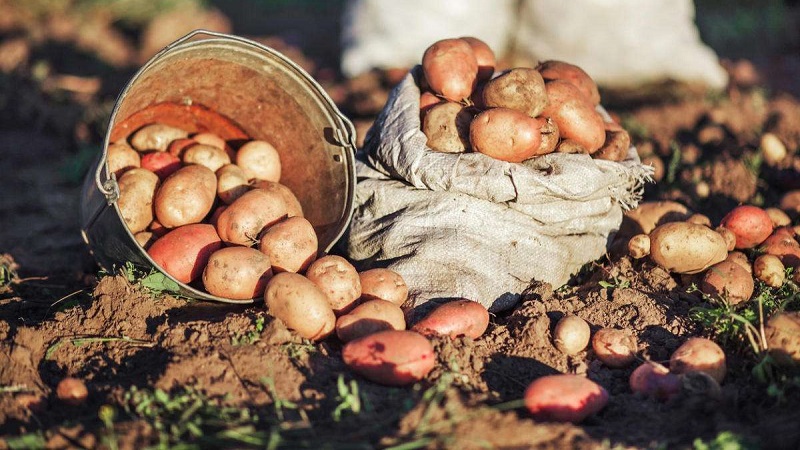
What harvest is considered good
A decent result for home cultivation is a value of 1:10.when 10 buckets of harvest are grown per bucket of seeds. Some gardeners get the result much better, digging up to 500 kg of potatoes from each hundred square meters.
In farms average yield in Russia - 100-150 kg per hundred square meters... But many have a lot of tricks and secrets that help to significantly increase this indicator.
How to grow potatoes correctly
Compliance with the technology from the beginning of planting to harvesting is one of the main conditions for obtaining a decent result. The main stages of cultivation that require attention: planting, grooming and prevention the appearance of diseases and pests.
Landing
The area for potatoes is prepared in advance - plow or dig deeply. Organic fertilizers are introduced: humus from straw, turf soil, peat, sawdust, compost, sand. Potatoes respond well to fertilizer from rotted manure and wood ash. Seeds are planted when the soil warms up to + 8 ... + 10 ° С.
Reference. According to popular beliefs, the time for planting potatoes begins when the foliage on the birches reaches the size of a ruble coin. The conditions during this period are really suitable for sowing activities.
Planting rules recommended for large tubers:
- the distance between the holes is from 25 to 30 cm;
- between the rows, leave at least 60 cm for manual processing, 70 cm for mechanical;
- the depth of the tuber embedding is 5-8 cm;
- on flat beds use a "checkerboard" planting method - a good method for small areas;
- in the holes - in the usual rows for sandy soil;
- in the "comb" - suitable for heavy ground.
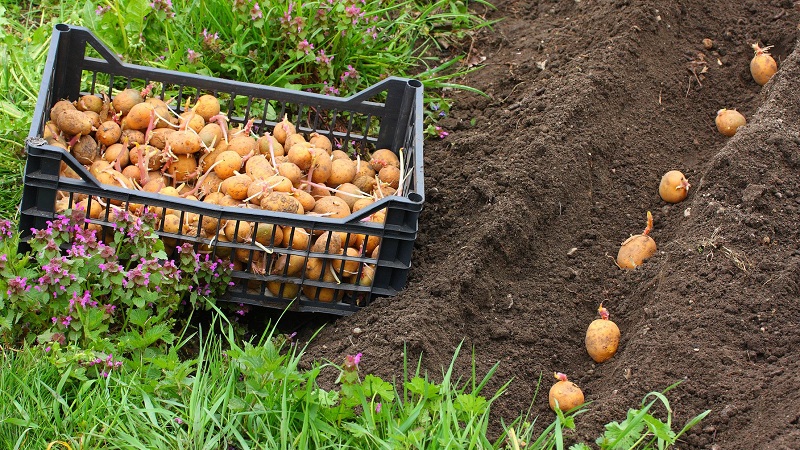
You can't thicken the ranks, since the bushes subsequently lose sufficient lighting and aeration of the roots.
Care
They begin to take care of the potatoes without waiting for the shoots to appear... A week after planting, the first hilling... A layer of loose earth 5-6 cm thick is thrown onto the place where each tuber is buried or on the ridge. The procedure is done 1-2 more times until the first shoots appear, once a week. The purpose of the event is to achieve that the underground part of the stem grows as long as possible - from 20 to 25 cm. It is on this part of the plant that the tubers are tied, and the more length is formed, the more potatoes will be.
After the emergence of seedlings, hilling is carried out another 1-2 times, destroy weeds and shovel a layer of soil above the roots of at least 5 cm. This helps to retain moisture in the soil and prevent the formation of a dense crust on the surface of the soil.
The plantation is watered at least three times per seasonif the amount of precipitation is average. Watering terms:
- At the beginning of bud formation.
- When all the buds are formed.
- Start flowering.
Watering is combined with dressing... To use organic fertilizers, they are prepared in advance - slurry or bird droppings are placed in a container and filled with water, left to ferment for several days. A solution for feeding is made from the finished mixture, diluting it with water in a ratio of 1:10.
Reference. Watering is not carried out if the season is rainy. In a hot summer, the site is moistened three to five times, each time after the procedure the soil is loosened.
Disease and pest control
Infections and pests most often attack potatoes if it has been planted in the same place for many years in a row. An effective way to get rid of them is a complex one, when mechanical methods, manual collection of insects and treatment with preparations are used.
Colorado potato beetle harvested by hand, and then the bushes are treated with "Fitoverm", "Agravertin", "Aktara". Medvedka is destroyed using traps: metal or plastic containers are buried in the ground upside down 3-4 cm below the surface level. Pour in a couple of tablespoons of vegetable oil and cover with plywood on top. A few days later, a bear that has fallen there by hand is collected. Often, pests are destroyed, leaving a poisoned bait near the plants: boiled grain, to which Metaphos is added (50 g per 1 kg of grain) and 2-3 tablespoons of vegetable oil.
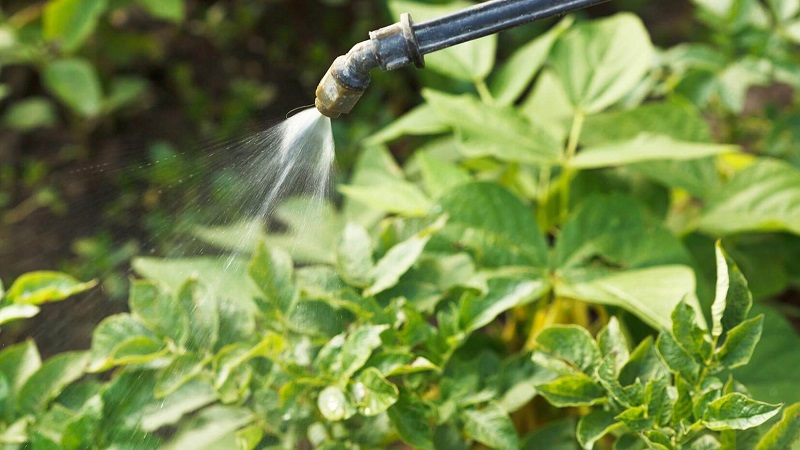
Wireworms are trapped in the form of "kebabs" - string pieces of root vegetables on a wire, then bury the bait to a depth of 10 cm in several places. After 2-3 days, the device is dug up and destroyed together with the parasites gathered in it. Create unacceptable conditions for wireworms: lure birds, destroy wheatgrass, deacidify the soil.
Nematoda is afraid autumn digging of soil, disinfection with potassium permanganate - the method is suitable for a small area, when the soil is spilled with a hot (at least 60 ° C) solution, and to enhance the effect, cover the surface with polyethylene. To protect against nematodes, seeds are dusted with ash before planting (100 g of wood ash per 10 kg). Urea is introduced to the surface of the earth - in the foci of infection, 1 kg per 1 sq. m.
In the fight against rodents help cats. They will catch the mice and scare away the rats that love juicy tubers.
Diseases most often develop due to contaminated seed... Exposure to pests also often leads to the appearance of rot. Frequent potato diseases: late blight, ring rot, black leg, common scab... To protect against infection, the tubers are treated before laying for storage, a 3% solution of bleach or a 5% solution of copper sulfate is used.
How to feed potatoes so that there are a lot of them
Potatoes respond well to the use of organic fertilizers, but if the land is infected with diseases and pests, chemical preparations are chosen - granular potash fertilizers with the addition of zinc, copper, boron, "Potato Kemiru", universal organomineral complexes marked "For potatoes". When preparing the soil, 5-6 kg of compost and 250-200 g of wood ash are introduced per 1 sq. m.
Alternative to compost - green manure: mustard, oats, phacelia, lupine. They are sown either in autumn (after harvesting) and leave the grown greens to decompose on the site during the winter, or in early spring. Spring green manure is mowed two weeks before planting potatoes, then used as mulch and fertilizer.
Feeding rules:
- during planting, nitrophosphate is introduced - 1 tsp. per hole;
- before flowering - root solution (300 g of urea per 10 liters of water);
- during the formation of buds - watered with a solution (1 tbsp. l potassium sulfate, 3 tbsp. l ash per 10 l of water);
- for the formation of tubers - watering with a solution (2 tbsp. l. superphosphate, infusion of mullein 1 glass, 10 l of water).
Water the bushes carefullyso that fertilizers do not fall on the leaves.
Reference. Top dressing is carried out in the evening, when the sun has dropped to the horizon. If this is done after the rain, the plants will get maximum benefit.
To make it big
When choosing a top dressing, take into account the ratio of trace elements that are in the composition... For the formation of large tubers, complexes containing an increased amount of nitrogen and potassium are used. Such preparations affect the size of the potatoes, but do not increase their number. Boron and magnesium in the composition of the fertilizer accelerate the formation time of tubers, helping them to reach large sizes even in a bad season.
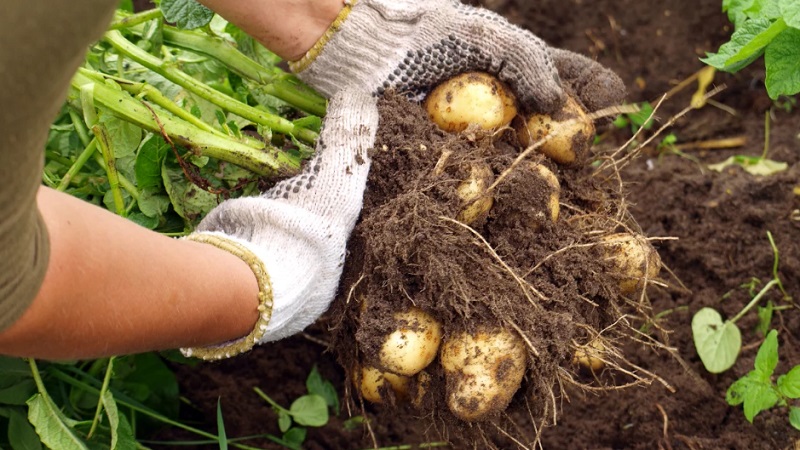
Farmer Secrets to Increase Yields
Each farmer has their own ways get a better harvest than neighbors. Such techniques are the result of many years of observation and a careful attitude to garden experiments.
Disinfection of seed potatoes
After sorting, warming up and germination, the seed potatoes are treated with special substances. How is disinfection carried out:
- 2 g of copper sulfate and 10 g of potassium permanganate are dissolved in 10 liters of water.
- The tubers are dipped in the solution for two minutes.
- Spread the wet potatoes in a thin layer on a dry surface.
- Allow to dry completely.
In addition to chemicals, there are folk recipes for disease prevention... Wood ash (1 kg) is dissolved in a bucket of water and the potatoes are lowered there directly in the net. After 1-2 minutes, the tubers are taken out, scattered and dried.
Application of nutrient solution before planting
Before germination, potato seeds are soaked in a nutrient solution... To do this, mix:
- 60 g superphosphate;
- 40 g of urea;
- 10 g of boric acid.
The dry mixture is dissolved in 10 liters of hot (at least + 70 ° C) water. When the composition has cooled, the tubers are placed in a warm liquid and left for 30 minutes. To stimulate growth 1-2 days before planting, the tubers are sprayed with drugs. The complexes "Poteytin", "Mikon", "Epin" are used.
Compliance with crop rotation
Correct rotation of crops that are grown on the same piece of land, will ensure the accumulation of useful organic substances in the soil... Since nightshades occupy a considerable area in vegetable gardens (in addition to potatoes, these are also tomatoes, eggplants, peppers), experienced gardeners use a two-field or three-field system. The field is divided and planted as follows:
- Potatoes on the first part of the garden. After harvesting, this place is sown with green manure.
- In the second part, cucumbers, cabbage, zucchini, pumpkin are grown.
- Legumes are grown on the third part.
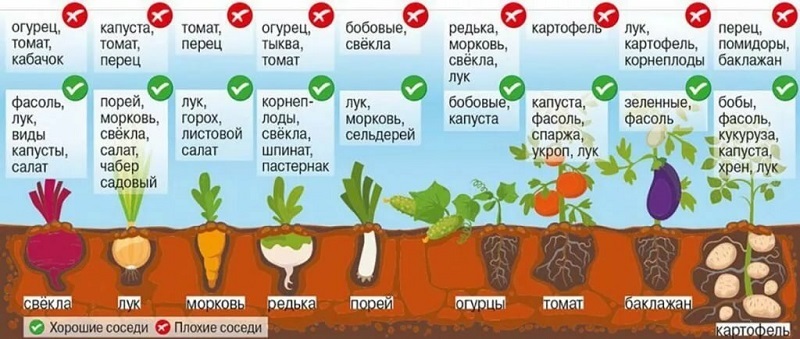
The next season they change the location in a circle - from the first part to the second, from the second to the third, from the third to the first. In a bipartite system, potatoes and other vegetables are swapped annually.
Stimulating incisions
Before germinating the eyes, the seed is stimulated using incisions - this increases the yield by 12-13%.
Two methods are used:
- Cross cut. Suitable for large tubers, which are cut perpendicular to the axis, leaving a small bridge of 1-2 cm intact.
- Annular cut. It is made on small tubers - in the form of a shallow (1 cm) cut encircling the entire circumference of the potato.
Breaking the nutrient bonds in the tuber allows both lateral and apical ocelli develop equally well, therefore, after planting, many stems are formed in the plant.
Reference. To avoid contamination of the seed with an infection, a careful selection of potatoes is carried out. The knife in the process is periodically disinfected in a solution of potassium permanganate.
Broken stems
2-3 weeks after flowering, the stems break - this is allows nutrients not to be consumed in large quantities for the development of leaves and tops... The stems are broken at a height of 10-15 cm from the ground so that they do not lose integrity, but cannot rise. The root system only benefits from this, directing nutrients to the development of young tubers.
Tips & Tricks
Experienced gardeners it is recommended to use elite seed material for planting at least once every few years, as domestic varieties grown for many years gradually degenerate. Wide row spacings are left to provide more space for light and ventilation. Using cut flower stalks, cut grass and weeds as mulch reduces moisture evaporation from the soil and attracts earthworms that loosen the soil.
Conclusion
To improve the yield of potatoes, it is not enough to fertilize the soil and hilling bushes. They also monitor the quality of the seed fund, plant it correctly, water it, observe crop rotation, and make top dressing. Experienced gardeners use the little tricks that we described in the article.